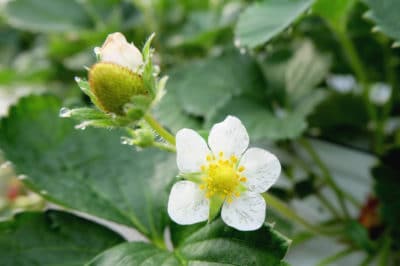The Bloom Process
Months before flowers emerge, the buds develop within the plant. This process begins after the strawberries have been harvested, usually in the late summer or early fall. The buds will go dormant over the winter. This early bud formation mans that as soon as spring conditions are right, the buds will quickly develop into flowers.
About the Blossoms
All strawberries have flowers, but they may vary according to variety. The typical strawberry flower has six petals, but varieties with five or even as many as eight may also occur. Most flowers are white; a few may be pink. The flowers nearly always appear above leaf level or protrude past the foliage. Once the fruit begins to develop, the weight of the berries pulls them closer to the ground.
Pollinating Strawberry Blossoms
Good pollination is key to fully-developed fruits. Each pistil must be pollinated for the berries to develop properly. Strawberries will self-pollinate but don’t usually have enough pollen to cover 100 percent of the pistils. Wind pollination accounts for a little more, but insects really make a difference. Any insect will do, with the honey bee taking top honors as a pollinator.
There are three kinds of strawberries. June bearers, as the name implies bloom around June; they only bloom and fruit once. Ever-bearers bloom and fruit in spring, then repeat the process in early autumn. Day-neutral strawberries are a form of ever-bearers, but it is temperature that controls blooming and fruiting. They will produce continuously with temperatures between 35 and 85°F (2 to 29°C).
Tending Plants During and After Bloom
Proper management during the blooming process and after harvest is critical. Proper care means:
- Ensuring rich, loose soil that drains well.
- Testing pH and keeping it between 5.5 and 6.0.
- Watering plants at all stages of growth and in dormancy if it is dry.
- Supplying nutrients in the form of commercial fertilizer or organic compost.
- Keeping weeds down.
When to Remove Blooms
The first year you plant strawberries, you want their energy to go into growing into strong plants. This is especially true of bare-root plants and crowns. The plants don’t know this, of course, and try to bloom, fruit and send out runners. Your plants will be much healthier and more productive if you resist the temptation to let them produce fruit. Cut or pinch off all runners and blooms as soon as you see them.
